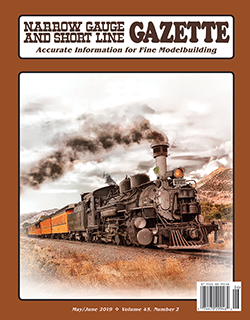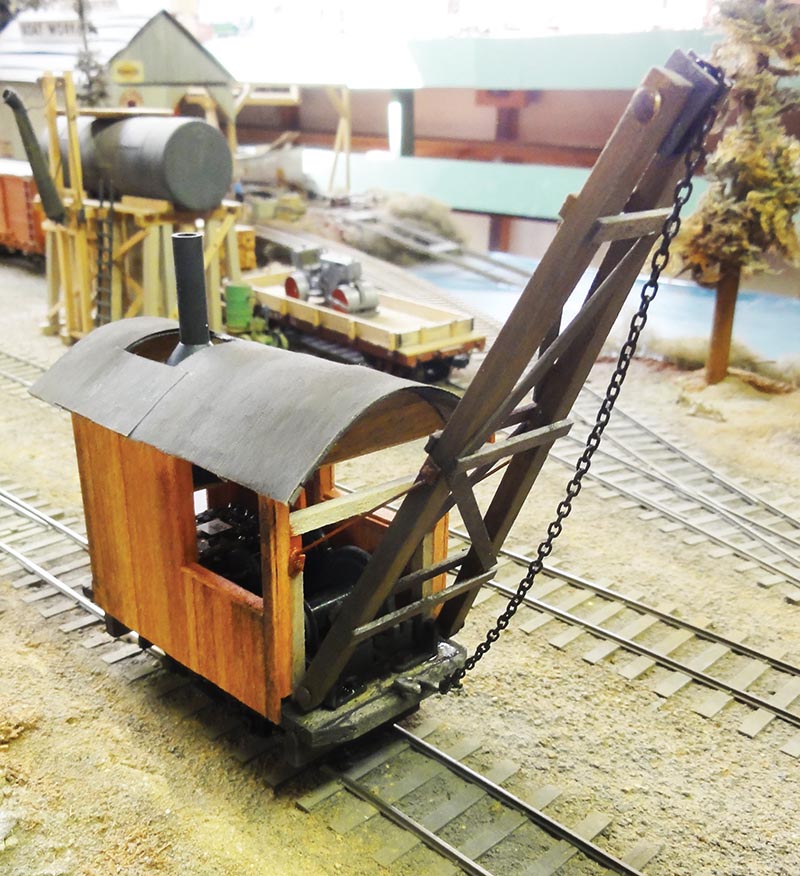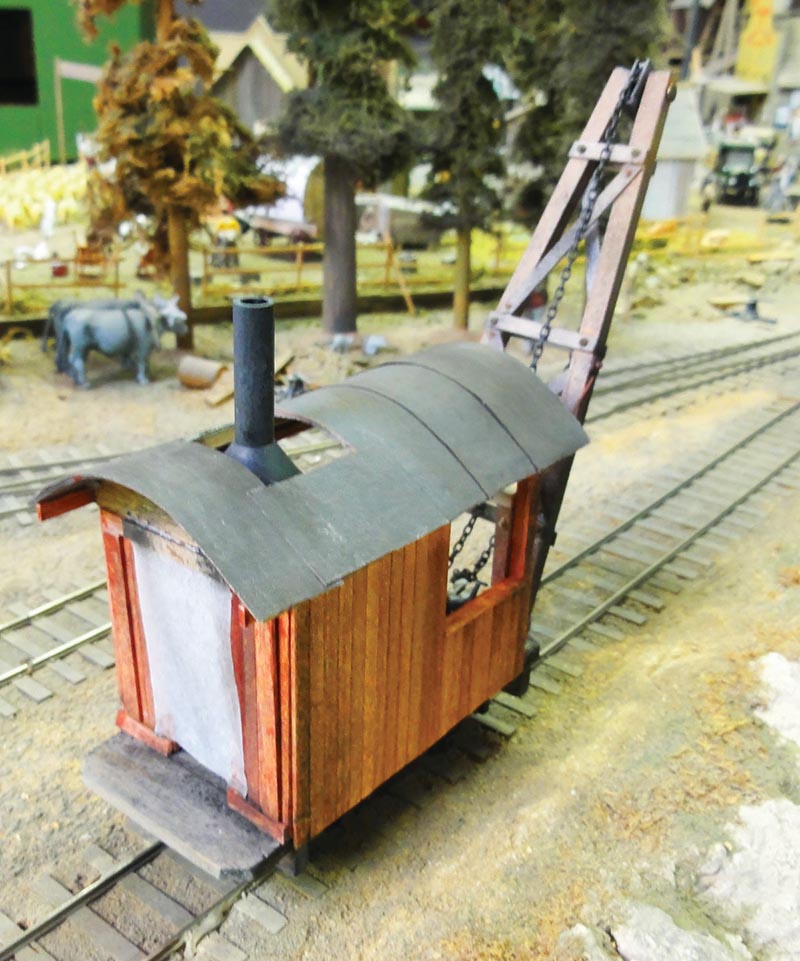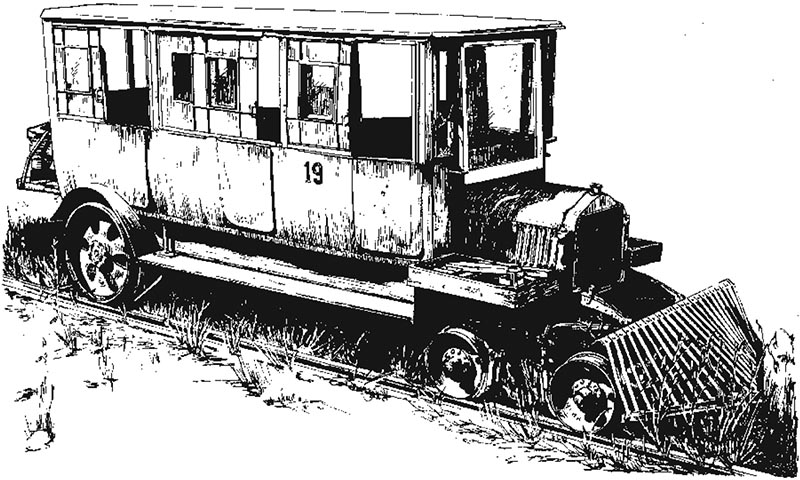 On pages 14 and 15 of the March/April 2018 Narrow Gauge & Short Line Gazette, I told how I re-gauged the mechanism of a Walthers HO gauge 0-4-0 Plymouth industrial switcher to On3.
On pages 14 and 15 of the March/April 2018 Narrow Gauge & Short Line Gazette, I told how I re-gauged the mechanism of a Walthers HO gauge 0-4-0 Plymouth industrial switcher to On3.
The model has a wonderfully smooth mechanism and comes with an installed decoder. However, the wheels are small for On3, and the wheelbase is only 4 scale feet. I mentioned that I wanted to use my converted mechanism in a steam crane, but couldn’t find a small enough prototype. So, I asked readers to send photos of really small cranes and I would build one. While I waited for photos to arrive, I used my re-gauged Walthers Plymouth mechanism to power one of my homemade logging “lokies.”
Photos of small cranes began to arrive. Several emailed by GAZETTE reader Gary Bothe depicted a small steam crane he had found in the “…wilds of Quebec Province in Canada” appealed to me, and I even published one of Gary’s photos in the July/August 2018 Pigeon Hole.
I did try to use the re-gauged Plymouth for the mechanism of a tiny steam crane. I even bought a second Walthers Plymouth Diesel, and also converted it to On3, but the underframe of the model “got out of hand.” Just seemed too bulky for the crane in Gary’s photo, but I went ahead anyway, and built and installed the crane’s unusual superstructure. But, the model just did not look right, so I scrapped the whole thing.
This is where the “cobwebs” came in — vague memories of a logging railroad somewhere in Northern California that had used 3-foot gauge passenger trucks as disconnected log trucks, and had converted one of them into a small switcher by adding the engine from some kind of tractor. I could mount my steam crane on a passenger truck. What a neat idea! And my vague memories included a book written about this railroad.

I couldn’t remember its title – so went to my shelf of logging books. There I found my copy of It’s Lonely At The Top, Narrow Gauge Logging in California’s Lake County (2008) by David J. Morgan, with commentary by David W. Braun. Lake County is in Northern California, and for many years local railroad lore said there was never a steam railroad in the county. However, according to this book, the W.W. Prather Lumber Company once operated a small Heisler in Lake County. And in 1941, the locomotive was found there, saved by a group of railfans, and moved south to Los Gatos, Calif. There, for many years, it sat on a short length of track at Billy Jones’ 15- inch gauge railroad. Eventually restored, the Heisler went back to Northern California to operate on Hal Wilmunder’s Antalope & Western Railroad, and later on the Camino, Cable & Northern. I believe this Heisler is now at the California State Railroad Museum in Sacramento. If so, let’s hope we will see it at the Thirtyninth Narrow Gauge Convention to be held there in September.
But — back to that switcher built on a passenger car truck. It seems that when Mr. Prather was starting his logging operation, he needed some inexpensive equipment. When he found that the Northwestern Pacific was re-gauging from 3-foot to standard gauge, the line’s Sausalito yard was full of 3-foot gauge equipment to be had “on the cheap.” So, he bought two Barney & Smith vintage passenger cars, and two Carter Brothers cars. He removed the trucks, took them to his logging site, added tie rods to strengthen them, and coupled them together with long poles called “roosters.” This gave him four pairs of disconnected log trucks.

But what about a locomotive? In that cobweb of memory, I imagined a gas switcher based on a passenger truck. But, I was wrong. Prather had his blacksmith attach the pedestals, and springs from a passenger truck to a frame of steel U-channels. Then he mounted the superstructure and engine from an International Model 8-16 tractor. You can see one of these tractors at the Heidrick AG History Center in Woodland, Calif., when you come to the Narrow Gauge Convention next September. Oh, by the way, did I mention that interesting little Lonely at the Top book has a plan for this little switcher?
Anyway, it quickly became evident that I could never hide the converted Walthers HO Plymouth Diesel ML-8 under some sort of tractor. So, after trying several ideas, I gave up and decided to just use it to build a steam crane. I just freelanced, not worrying about a prototype, and raided my scrapbox for parts. I found a Bachmann donkey engine and a pair of Grandt Line On3 passenger trucks. I built a wood deck on my converted Walthers Diesel mechanism, made a cover over the decoder, framed up the cabin of the crane, and added individual strips of pre-colored wood on its sides and ends.
The roof was cut from sheet basswood (see Wondercutter review, page 13), and covered with “tarpaper.” I had to cut the Bachmann boiler way down, and mount it on the cover over the decoder so it sticks out of the roof. The cylinders had to be cut off the Bachmann winch so it would fit inside my cabin. The crane’s boom is stripwood with some odds and ends of detail parts, and I ran a chain over the pulley at the top of the boom. I had to hide the butchery on the boiler with a piece of tissue paper to represent a canvas curtain. The last step was to ACC one Grandt Line passenger truck side frame on each side of my mechanism where it just fit.
So, Gary, there you have it — a smooth-running little steam crane! But, I wish it were smaller. Maybe those cobwebs will clear, and I’ll find an even smaller prototype.
—Bob Brown, Editor



